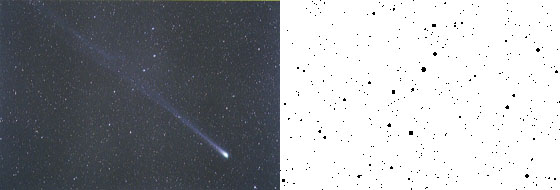Home Page Sat Dec 6 19:31:03 JST 1997
   Next: Image composition Up: Interim Report on Matching Previous: Star detection and noises |
Accuracy of matchingIn this section I verify the accuracy of matching using images of Nova Cas 1995 as examples. The PIXY system returns the mapping function between a coordinate on the original image x,y and that on the chart (R.A. and Decl.) as a result of matching. Therefore the user can obtain the R.A. and Decl. of each detected star by clicking it on the display. After matching the two images of Nova Cas 1995 listed up in Section 2 ( Nova1995Cas-1.gif , Nova1995Cas-2.gif ), the R.A. and Decl. of the nova was obtained as follows.
The true position of the nova is: R.A.= 1h 5m 5.353s, Decl.=+54o0'40.13''. So the positional error is about 4 arcsec. The width of the images is 466 pixels, the view width is 1.17 deg, so the pixels size is about 9 arcsec. Therefore the positional accuracy of detected stars after matching is about half of the pixel size or more precise. As I mentioned in the previous section, the process of star detection is still preliminary. So the positional measurement should also have some errors. In addition, the stars in these images of Nova Cas 1995 are trailed because of a guiding error. However, this result implies that the user can measure the positions of stars precisely if the matching process works well. But the accuracy becomes much worse for very wide images. For example, the image of Comet Hyakutake (b2_0327.jpg) has about 60 deg view width. In this case, although the precise position was obtained in the center, the positions of stars in the circumference are extremely different as you see here.
|


